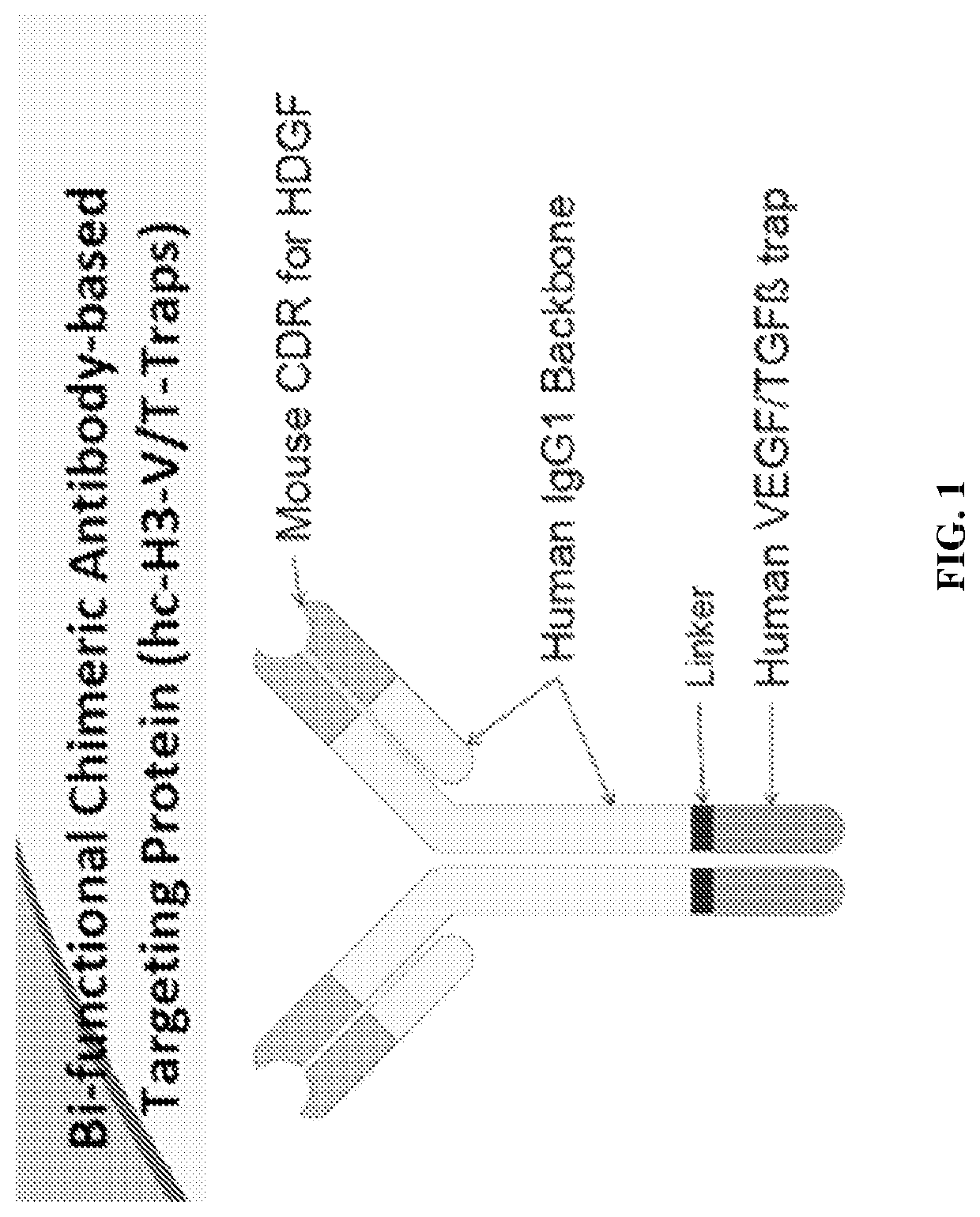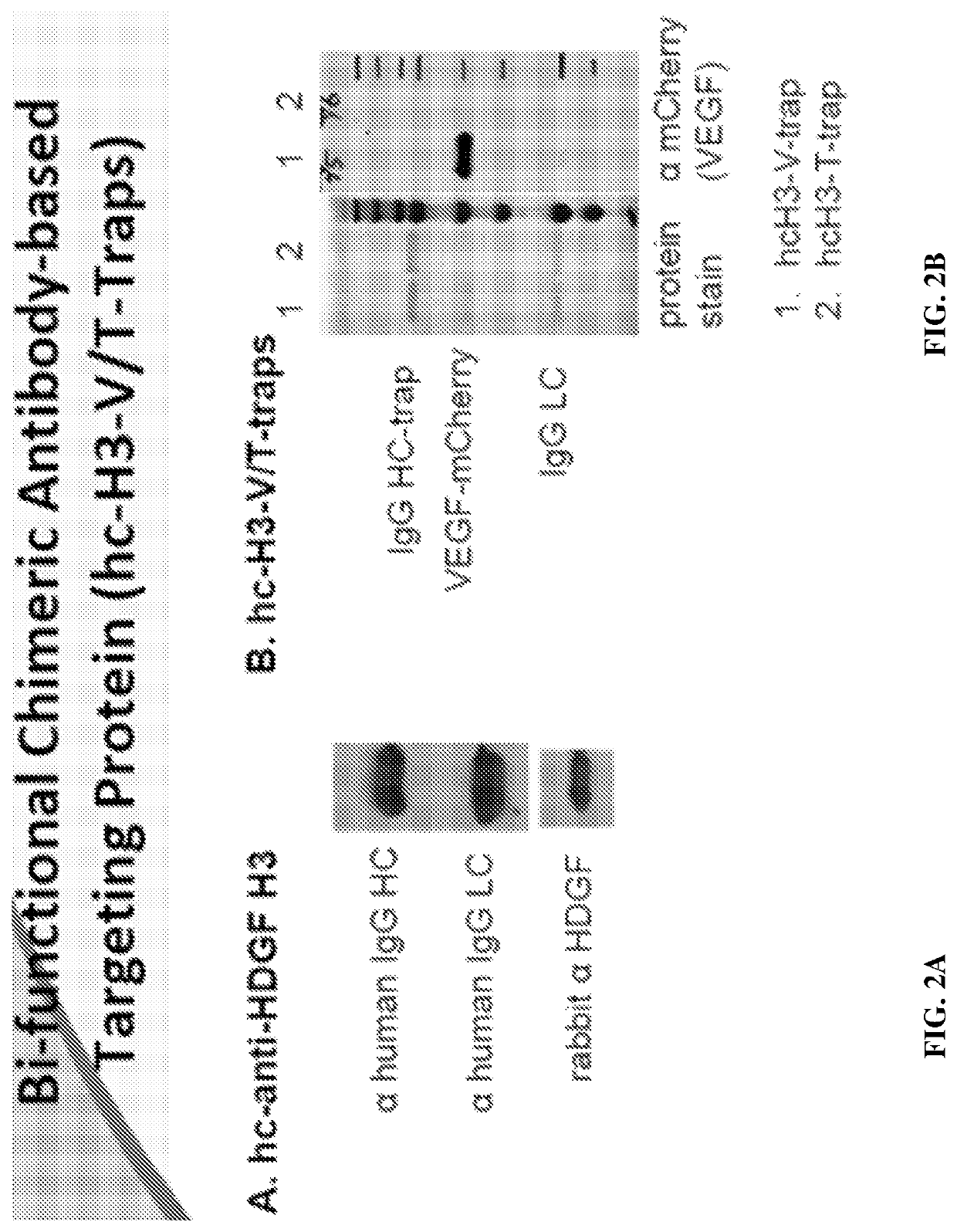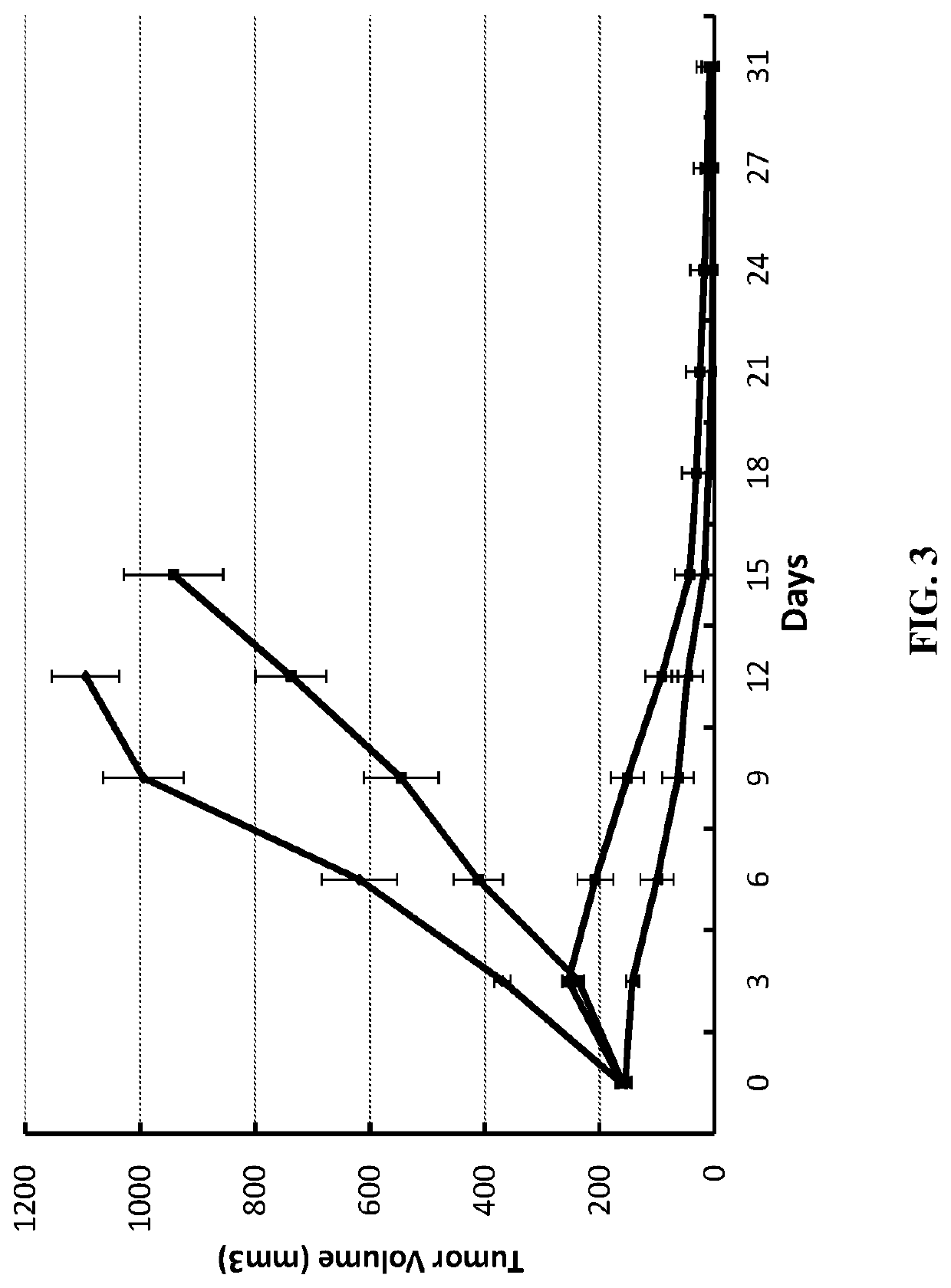Methods of treating cancer using bifunctional molecules that target growth factors
a technology of growth factor and cancer, applied in the direction of antibody medical ingredients, peptide/protein ingredients, metabolism disorders, etc., can solve the problems of life-threatening interstitial lung diseases, idiopathic pulmonary fibrosis, and no cure currently, so as to improve the effect of administration and ease of administration
- Summary
- Abstract
- Description
- Claims
- Application Information
AI Technical Summary
Benefits of technology
Problems solved by technology
Method used
Image
Examples
example 1
n of Anti-HDGF Antibody Secreting Hybridoma Clones C1, C4, H3, and L5-9
[0149]To explore a bi-functional antibody-based therapeutic strategy, a panel of anti-HDGF antibodies (HDGF-C1, -C4, -H3, and L5-9) as previously described in Table 1 were created to bind native HDGF. In some embodiments, the antibodies are IgG1 and recognize HDGF and can recognized modified forms or variants, or fragments of HDGF. The cDNA fragment that encodes HDGF was PCR amplified and cloned into pGEX-4-T1 vector (GE Health Care, Piscataway, N.J.). The resulting plasmid, pGST-HDGF, was used to generate GST-HDGF fusion protein in E. coli strain BL21 (DE) 3. The recombinant protein was purified using GST affinity chromatography. Balb / c mice were then immunized with the fusion protein and boosted twice. Three days after the last boost, mice were sacrificed and spleenocytes were fused with P3X63Ag8.653 cells followed by culturing in selecting medium. Anti-HDGF antibody secreting hybridoma clones were identified a...
example 2
Anti-HDGF H3 Antibody (hH3)
[0151]The humanized anti-HDGF H3 (hH3) was created by grafting the complement determent region (CDR) of mouse H3 to a human IgG1 framework. Methods for making monoclonal mouse H3 antibody are described in Ren, H., et al., “Antibodies targeting hepatoma-derived growth factor as a novel strategy in treating lung cancer,” Mol Cancer Ther. 2009 May; 8 (5): 1105-1112.
[0152]Humanization of H3 was performed to generate a humanized H3 (hH3) monoclonal antibody by the CDR grafting method. Usually, rodent antibodies can be immunogenic to human and cause very serious side effects including the HAMA (human anti-mouse antibodies) response or anaphylactic shock. With this CDR grafting approach, CDR loops that make up the antigen-binding site of the mouse Mab are grafted into corresponding human framework regions. Initially, the variable light and heavy chain sequences of H3 were determined as shown in Table 3. To do so, H3 hybridoma cells were harvested by centrifugatio...
example 3
ion of Chimeric H3 Antibody (cH3)
[0155]The chimeric H3 was constructed by fusing the variable domain of mouse anti-HDGF H3 with human IgG1 constant region. Sequences are provided below.
[0156]
TABLE 4Chimeric H3 sequences with variable domain frommouse and human IgG1 constant region.3.1 Heavy chain. SEQ ID NO: 21.MVSTAQFLGLLLLCFQGTRCQITLKQSGPGIVQPSQPVRLTCTFSGFSLSTSGIGVAWIRQPSGKGLEWLATIWWDDDNRYNPSLKSRLAVSKDTSNNQAFLNIITVETADTAIYYCAQIYDYAVGFAYWGQGTLVTVSSASTKGPSVFPLAPSSKSTSGGTAALGCLVKDYFPEPVTVSWNSGALTSGVHTFPAVLQSSGLYSLSSVVTVPSSSLGTQTYICNVNHKPSNTKVDKKVEPKSCDKTHTCPPCPAPELLGGPSVFLFPPKPKDTLMISRTPEVTCVVVDVSHEDPEVKFNWYVDGVEVHNAKTKPREEQYNSTYRVVSVLTVLHQDWLNGKEYKCKVSNKALPAPIEKTISKAKGQPREPQVYTLPPSRDELTKNQVSLTCLVKGFYPSDIAVEWESNGQPENNYKTTPPVLDSDGSFFLYSKLTVDKSRWQQGNVFSCSVMHEALHNHYTQKSLSLSPGK3.2 Light chain. SEQ ID NO: 22.MVSTAQFLGLLLLCFQGTRCDIQMTQTTSSLSASLGDRVTISCRASQDISNYLNWYQQKPDGTVKLLIYYTSRLHSGVPSRFSGSGSGTDYSLTISNLEPDDIATYYCQQYGKLWTFGGGTKLEIKRTVAAPSVFIFPPSDEQLKSGTASVVCLLNNFYPREAKVQWKVDNALQSGNSQESVT...
PUM
| Property | Measurement | Unit |
|---|---|---|
| body weight | aaaaa | aaaaa |
| pH | aaaaa | aaaaa |
| chemiluminescent | aaaaa | aaaaa |
Abstract
Description
Claims
Application Information
 Login to View More
Login to View More - R&D
- Intellectual Property
- Life Sciences
- Materials
- Tech Scout
- Unparalleled Data Quality
- Higher Quality Content
- 60% Fewer Hallucinations
Browse by: Latest US Patents, China's latest patents, Technical Efficacy Thesaurus, Application Domain, Technology Topic, Popular Technical Reports.
© 2025 PatSnap. All rights reserved.Legal|Privacy policy|Modern Slavery Act Transparency Statement|Sitemap|About US| Contact US: help@patsnap.com



